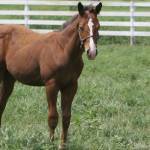Feed Management for Weanling and Yearling Horses

Young horses need the best-quality feeds to meet their requirements for growth and free exercise. If you are using a commercial mixed feed, make sure it is formulated for the growing horse.
Energy
Oats are usually the cheapest source of energy for young horses and are best fed crushed to weanlings because their teeth are not fully developed and they will have trouble breaking open whole grains. Crushed maize (corn), rice, and barley are other grains that are good sources of energy for the growing horse. A general rule of thumb is to provide 1 kg (2.2 lb) of fortified grain per 100 kg (220 lb) of body weight, up to a maximum of 3 kg (6.6 lb)/day per weanling.
Protein
Weanlings need 15% crude protein and yearlings need 13% crude protein in the diet. Young green grass/clover pasture contains 15–20% crude protein, but this amount falls rapidly as the plants begin flowering and go to seed. Dry summer pasture contains very little protein, so yearlings will need supplementation. Young horses need high-quality protein that contains all the essential amino acids, especially lysine. Animal-derived proteins such as milk powder are of very high quality and soybean meal is the best-quality vegetable protein. Lucerne (alfalfa) also has a high level of good-quality protein. Linseed meal is relatively low in lysine and is not a good source of protein for growing horses, although its high oil content will produce a bloom on the coat.
Vitamins and Minerals
Calcium and phosphorus are the most important minerals for growing horses. Grains are low in calcium, whereas lucerne (alfalfa) and clover hays and high-quality pasture contain more calcium. Dicalcium phosphate and ground limestone are the cheapest supplements and you generally need 30–50 g/day. Unless you are feeding a mixed balanced feed, you will need to add limestone to grains, or dicalcium phosphate if the ration contains lucerne (alfalfa). Bran contains a lot of phosphorus and should not be fed to growing horses. Urinalysis can be used to asses the calcium status of young horses, or the calcium/phosphorus balance of the ration can be anhttp://www.equinews.com/article/providing-dietary-calcium-and-phosphorus-horsesalyzed by an equine nutritionist.
Young horses running in a paddock or regularly being longed can lose 30–50 g of salt per day in their sweat and urine, especially during hot weather, so provide a trace mineralized salt block or supply a salt supplement.
Trace minerals such as copper, zinc, manganese, and selenium are important components in the diet for most growing horses, and are supplied in the right quantities and ratios in commercial feeds formulated for young horses.
Roughage
To meet the commercial growth requirements of young horses, you may have to feed them less roughage than is desirable for optimal digestive function. Therefore, you must use good-quality chaff or hay to maximize the utilization of the fibrous feed in meeting the energy requirements and so decrease the amount of starch the weanling has to be fed. High-quality, early-cut hay will also minimize the pot-bellied appearance caused by the fiber and water in the gut, a situation often associated with mature hay of high lignin content. Lucerne (alfalfa) or clover hay will also supply protein and calcium as well as fiber, so they are preferred for growing horses and should be fed on demand.








